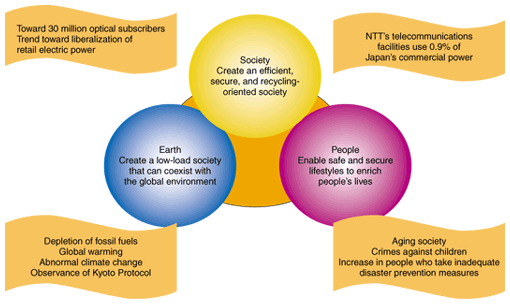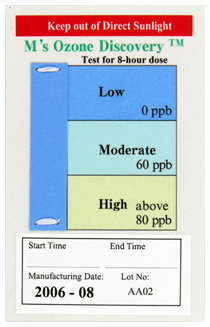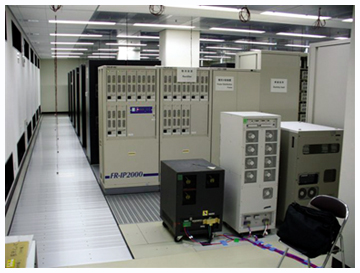 |
|||
|
|
|||
|
Spotlight on NTT Laboratories Vol. 5, No. 12, pp. 8–11, Dec. 2007. https://doi.org/10.53829/ntr200712lab  Easing the Load on the Global Environment through International Contributions to the Energy and Environment FieldsLocated in the Musashino R&D Center, NTT Energy and Environment Systems Laboratories is involved in diverse projects with the aim of reducing the load on the global environment. We talked to General Manager Toru Maruno to find out more about R&D toward a sustainable society, the technologies that are being developed and key issues, and international activities. Role and mission of Energy and Environment Systems Laboratories—What is the role of NTT Energy and Environment Systems Laboratories in NTT? Research and development in energy- and environment-related topics were originally conducted at the Telecommunications Energy Laboratories and Lifestyle and Environmental Technology Laboratories in the NTT Science and Core Technology Laboratory Group. As a result of social changes, however, it was eventually recognized that energy and environmental issues were becoming an integral part of daily life, so these laboratories were integrated to form the NTT Energy and Environment Systems Laboratories in July 2002 to enable comprehensive treatment of energy and environmental problems. The idea here was to move from a research structure that emphasized basic research to one promoting system and product development. At present, the NTT Energy and Environment Systems Laboratories is part of the NTT Information Sharing Laboratory Group. —What is the mission of NTT Energy and Environment Systems Laboratories and what are its key research themes? As the name implies, R&D at our laboratories is concerned with two fields: the environment and energy. And we are faced with two major issues: how to reduce our consumption of energy and how to preserve the environment. Both of these issues are now receiving a lot of attention in society, and our mission is to come up with appropriate solutions (Fig. 1).
To be more specific, we are developing technologies related to four key research themes. First, we must research and develop technologies for achieving a sustainable society. Second, we must utilize the fruits of NTT's traditional research in telecommunications to develop technologies that can expand NTT's business areas and contribute to energy and environmental measures. Third, we must find ways of reducing the amount of energy required to run telecommunication facilities and operating them in a more efficient and effective manner. And fourth, we must construct energy-supply systems that enable users to communicate whenever they want while maintaining reliability. —The keyword ˇČenvironment” makes many people think of environmental problems such as global warming. In what ways are ICT and environmental problems connected? The meaning of ˇČenvironment” is very broad. To begin with, information and communications technology (ICT) encompasses infrastructure and equipment that consumes a large amount of power. This power is obtained through electric power generation processes that emit CO2 as a side-effect. We therefore need to reduce—as much as possible—the amount of power consumed by ICT in order to effectively reduce CO2 emissions. We also consider that the use of ICT can make a positive contribution to the environment in both direct and indirect ways. For example, we know that chemicals, including toxic substances, are being emitted in the atmosphere and indoor environments. To prevent such emissions, it is essential to detect and analyze airborne substances to determine what they are and whether they are toxic. A mechanism that can deliver such information to the right people in real time must be constructed. ICT can be very effective in collecting that information, storing it in a database, and analyzing it, and in sending the analysis results to the appropriate people regardless of the distances involved. Through technology development, we can create sensors for detecting toxic substances and platforms for analyzing and processing collected information so that the analysis results can be used for environmental assessment. To give a more familiar example, business people in Japan often use the Shinkansen (bullet train) or airplanes to attend meetings. This movement involves the use of electric power, fossil fuels, and other forms of energy. As an alternative, videoconferencing could be used effectively to cut down on human movement and reduce CO2 emissions. Thus, we can regard ICT as a tool having the double effect of saving energy and preserving the environment. Technology for dealing with disasters and toxic substances—NTT Energy and Environment Systems Laboratories is also researching and developing disaster-prevention and disaster-related information sharing technology. In light of the Niigata-Chuetsu Offshore earthquake in Japan in July this year, what technologies are you developing as an infrastructure to be used at the time of a disaster? First of all, we need technology for obtaining information at the time of a disaster. Second, we need technology to enable makeshift communications when a disaster occurs. NTT's Disaster Message Dial Service (171) enables messages to be recorded and saved at the time of a disaster such as an earthquake so that information about the safety and whereabouts of people in the stricken area can be obtained. And to provide a temporary relay station, a mechanism that provides communications in the stricken area from a simple radio unit mounted on a motorcycle is being constructed. This can be powered by a portable nickel metal hydride battery that can be transported to a stricken area in an emergency as a backup power supply. At first glance, these measures may not seem to be connected to the environment, but technologies for dealing with disasters and for promoting disaster prevention are being researched with the aim of predicting what might happen to the environment and of storing and providing such information. And some of the technologies that are being researched and developed to solve environmental problems can also be applied to disaster prevention. Our role is to make social contributions through such technologies. —With research connected to practical applications, what kind of products are you putting on the market? We have developed two key products for checking ambient conditions: an ozone sampler (ozone sensor) [1] and an ozone badge. These devices help with ozone exposure management. Ozone is commonly used to disinfect tap water and medical instruments, and it has proved to be very effective for this purpose. However, exposure to or inhalation of large amounts of ozone can be harmful to the human body, so the concentration of ozone in the air needs to be managed. The ozone sampler collects data on ozone concentration, so it can also be connected to a communications link. The ozone badge, on the other hand, is a simple tool for indicating ozone concentration through a change in color. Key issues and international activities—What kind of issues do you face in the R&D of energy and environment systems? Whether for energy or the environment, research and development will come to involve composite technologies, so we must solve various problems simultaneously. For example, we need to consider not only materials but also the products that will combine those materials, and we must be able to integrate those products smoothly into operating systems. Technology has many faces, and we must work to select and combine a wide range of elemental technologies in an optimal form according to the objectives at hand and the place of use. The difficulty involved in moving forward with a specific product that has been deemed necessary is an issue that we must deal with. —It appears that NTT Energy and Environment Systems Laboratories is active in international personnel exchanges and joint research. Our strategy is to expand globally because environmental and energy problems can no longer be solved within just one country. Therefore, we wish to deepen our cooperative relationships including the formation of alliances with many countries. Considering that our strength lies in technologies that originate in communications, the goal of our global strategy is to use those technologies as a basis for expanding overseas and to have our overseas customers use them and find them useful. To this end, it is essential that we exchange and share information on an ongoing basis with overseas telecommunication carriers and universities and research institutions. In recent years, there has been an increase in corporations—both in Japan and overseas—that do not have their own research institutions. Perhaps this is why the research that we have been performing has been receiving a lot of attention from organizations both inside and outside Japan. In this sense, the development of elemental technologies in the energy and environment fields is a role that NTT Energy and Environment Systems Laboratories plays on the world scene. Since the spread of ICT has resulted in greater energy consumption, it is important that we find ways of reducing that consumption and of operating facilities more efficiently. In this regard, the technologies being studied by NTT Energy and Environment Systems Laboratories will certainly be needed not only in Japan but throughout the world as well. Energy and environmental problems are deeply entwined with national policies, and we also serve as members of various committees including the Advisory Committee for Natural Resources and Energy at the Agency for Natural Resources and Energy of the Ministry of Economy, Trade and Industry and the executive committee of the International Conference on EcoBalance sponsored by the Life Cycle Assessment Society of Japan. We are moving forward with R&D while participating in a variety of activities. Through these efforts, we should be able to reduce CO2 emissions and the amount of toxic substances. I believe that we can contribute to a better environment by solving energy-related issues. Reference References
Background to the founding of NTT Energy and Environment Systems LaboratoriesNTT Energy and Environment Systems Laboratories came into being through the integration of the Telecommunications Energy Laboratories and the Lifestyle and Environmental Technology Laboratories. Its aim is to integrate the work of those two laboratories to create a safe and secure recycling-oriented society with a minimal environmental load. Ozone badgeThe ozone badge mentioned in the article is shown in Photo 1. Its active region (vertical blue strip on the left) turns white when the badge is exposed to a large amount of ozone. This badge, which is just the size of a business card, is being used in the United States.
Area for power-supply experimentsThis area is located in the basement of the Musashino R&D Center (Photo 2). With a floor space equal to the size of a 25-meter swimming pool, it includes space for simulating a telecommunication equipment room. This area is used for research and development of power supplies for new telecommunication equipment to be deployed by NTT so that this equipment can be operated in a safe and efficient manner.
|
|||










